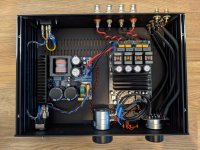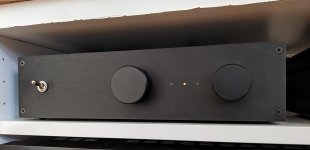D
Deleted member 148505
PFFB has a crisp sound so the mod will also make the sound rounder. For ex. you can notice it on guitar plucking etc..
After some listening comparison with only 1pF, I noticed that it removes crisp and some air compared with default, so I think not everyone will like it.
Yes, I recommend it only if you like PFFB. Use only around 1pF to 3pF, (not 10pF to 22pF as stated before). Too much and it will affect high frequency response.
For the SQ, vocals will be improved, but will make it slightly more forward sounding. PFFB has a crisp sound so the mod will also make the sound rounder. For ex. you can notice it on guitar plucking etc..
Hint for you JLester.
US20110068864A1 - Self oscillating class D amplification device
- Google Patents
Use this for 3255- 20-25db in-loop reinforcement.
My best sounding Sylph-D200 here has the following configuration.
10uF Elna Silmic II
Panasonic FC 50V 1500uF PVDD bulk caps
6.8uH Coilcraft + 0.68uF output cap.
1.5X gain (default is 1.3X)
450kHz Sw freq (default)
non-pffb
43VDC supply
The voice is very good and life-like and highs are very smooth even if I use it with my cheap chinese meanwell clone supply.
The only drastic change between the modules is the choice of output inductor and output cap. So I think for existing users, since changing the output inductors is expensive, a cheap upgrade will be the output filter caps, since it can add improvements in the sound.
Hello i have Sylph D200 so to improve SQ i have to:
1) set gain to 1,5 (How can set?)
2) change 0.68 output caps with something better
Any advise?
D
Deleted member 148505
Hint for you JLester.
US20110068864A1 - Self oscillating class D amplification device
- Google Patents
Use this for 3255- 20-25db in-loop reinforcement.
Much appreciated, thanks.
I stumbled upon your group buy thread and saw that you catastrophically failed to deliver your modules on time. My advise for you is that you need to redesign your board such that all the SMT components are assembled either on top side or bottom side. Or, you can use a vertical daughtercard for SMT parts.
That way, SMT assembly can be outsourced cheaply to any PCB manufacturers.
Also I see no advantage of using a plate heatsink configuration with present TPA3255 chip, continuous full power is not possible because the problem is in the rate of transfer of heat from a very tiny area of the IC to the heatsink itself. It's only designed for home use so EVM heatsink is sufficient.
D
Deleted member 148505
Hi I only placed the gain on the specs but that is irrelevant to SQ if your source can output large signals.Hello i have Sylph D200 so to improve SQ i have to:
1) set gain to 1,5 (How can set?)
2) change 0.68 output caps with something better
Any advise?
You can only use 0.68uF output caps if your output inductors are 6.8uH (or 7uH).
My advise is to find a high quality 1uF cap with 15mm lead spacing. Effect of changing with better output cap is in the voice, it will be more open (exaggerated:something like voice with face mask and no face mask)
Unfortunately I can't include premium output caps because profit margin right now is very low.
Manufacturing a single Sylph-D200 board with only SMT parts (almost bare) without TPA3255 IC soldered is more expensive than a complete shui yuan board. Primarily because of the ultra low noise regulators, overspec'ed tantalums, and C0G caps in some areas.
I might change the regulators in the future to bring the price down.
Regards,
Lester
D
Deleted member 148505
Hello i have Sylph D200 so to improve SQ i have to:
1) set gain to 1,5 (How can set?)
2) change 0.68 output caps with something better
Any advise?
Also use a single supply on Sylph-D200. If you'll use a dual supply, its output voltage will fluctuate on high current draw.
Regards,
Lester
Attachments
Very nice - what volume and selection controls are you using?
Thank you.
I use this 10k potentiomenter for volume control
Hallo ENDE EIZZ Potentiometer schalter 2,0 CH high prazision 24 schritte Dual Einheit Stereo Volumen Potentiometer 10K 25K 50K 100K 250K|Amplifier| - AliExpress
and this input switch
EIZZ 3 Moglichkeiten 4 Moglichkeiten 3 Positionen Drehschalter Signal Source Selector Aluminium Schild 12 Gold Uberzogene Kupfer Pins Hifi audio DIY|audio amp|amp diyaudio amp diy - AliExpress
Hi, I have started an amplifier based on SYLPH-D200 TPA3255 modules. I used a configuration based on PFFB. First impressions. The sound is correct. No noise at all. Nevertheless, listening to it makes me a bit fatiguing.Something is missing or a little irritates me. I do not know. Maybe it is the lack of warming up the amplifier or maybe it is the use of PFFB?
For comparison, I use four other amplifiers every day: based on modules First One ver. 1.4, based on modules Hypex UCD400HG, based on modules Zappulse 2.3 and Powerdac Mini 151.
Each of them has a slightly different sound signature. As for me, the best sound is provided by the amplifier based on First One modules. Hypex is close to it, but more boring and at the same time a bit irritating (something is missing).
Built amplifier on SYLPH-D200 TPA3255 modules has the most similar sound to UCD400HG. This is a very good amplifier, superior to many others available on the market for much more money, but....
I will try to turn off the PFFB this coming weekend. We'll see what that does.
For comparison, I use four other amplifiers every day: based on modules First One ver. 1.4, based on modules Hypex UCD400HG, based on modules Zappulse 2.3 and Powerdac Mini 151.
Each of them has a slightly different sound signature. As for me, the best sound is provided by the amplifier based on First One modules. Hypex is close to it, but more boring and at the same time a bit irritating (something is missing).
Built amplifier on SYLPH-D200 TPA3255 modules has the most similar sound to UCD400HG. This is a very good amplifier, superior to many others available on the market for much more money, but....
I will try to turn off the PFFB this coming weekend. We'll see what that does.
Attachments
-
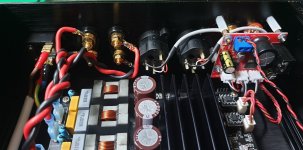 20210704_175444.jpg197.6 KB · Views: 222
20210704_175444.jpg197.6 KB · Views: 222 -
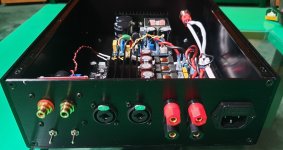 20210704_174546.jpg177.8 KB · Views: 233
20210704_174546.jpg177.8 KB · Views: 233 -
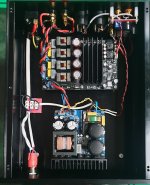 20210704_174357.jpg285.7 KB · Views: 225
20210704_174357.jpg285.7 KB · Views: 225 -
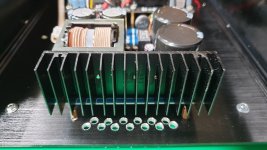 20210704_115820.jpg187.2 KB · Views: 212
20210704_115820.jpg187.2 KB · Views: 212 -
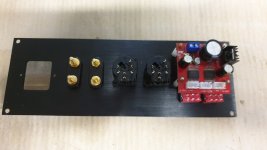 20210626_173509.jpg114.1 KB · Views: 195
20210626_173509.jpg114.1 KB · Views: 195 -
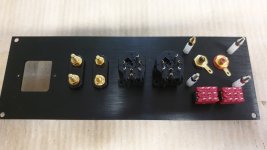 20210626_173458.jpg120.6 KB · Views: 208
20210626_173458.jpg120.6 KB · Views: 208 -
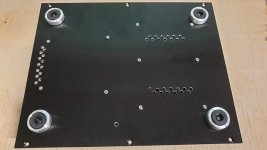 20210626_173444.jpg132.9 KB · Views: 439
20210626_173444.jpg132.9 KB · Views: 439 -
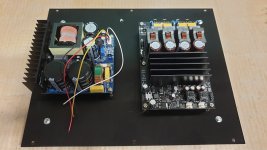 20210626_173431.jpg179 KB · Views: 467
20210626_173431.jpg179 KB · Views: 467 -
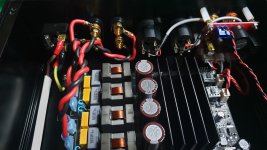 20210704_174338.jpg178.5 KB · Views: 467
20210704_174338.jpg178.5 KB · Views: 467
D
Deleted member 148505
Thanks for the objective review.
For the fatiguing sound it is mainly influenced by the OPA1656. The sound of OPA1656 is very clear ,and the highs are smoothened out, but like what I've said before, it is sharp sounding and fatiguing to some users, maybe depends on music genre too. Output inductors and caps are the next suspect, you can upgrade the output caps, the PCB can accept 15mm lead spacing polypropylene caps..
For "something is missing" sound, try to equalize and bump up the 180Hz to 240hz "lower midrange". If it sounds better, then you need to turn off the PFFB.
Regards,
Lester
For the fatiguing sound it is mainly influenced by the OPA1656. The sound of OPA1656 is very clear ,and the highs are smoothened out, but like what I've said before, it is sharp sounding and fatiguing to some users, maybe depends on music genre too. Output inductors and caps are the next suspect, you can upgrade the output caps, the PCB can accept 15mm lead spacing polypropylene caps..
For "something is missing" sound, try to equalize and bump up the 180Hz to 240hz "lower midrange". If it sounds better, then you need to turn off the PFFB.
Regards,
Lester
D
Deleted member 148505
Also, instead of using this module, you can use a DPDT switch to select from Balanced to SE toggling. Looks like this module degrades the sound.
Thank you for trying to help. The module shown in the picture is only used to symmetrize the signal from the RCA sockets. I did not use it, because for testing the amplifier balanced signal was fed to the xlr sockets.
As I already wrote at the weekend I will try to disable the PFFB. I hope it will do something.
I didn't wait until Saturday and just now disassembled the amplifier. And I checked the jumpers switching on the PFFB. Well, contrary to my request when placing the order, it was not turned on. So my previous observations referred to the amplifier without PFFB (take a look at the photo).
I immediately connected the jumpers with solder. I plugged the amplifier into the sound source. And finally it is reasonably good for me. The sound gained life, air, clear sound of instruments. Unpleasant impressions disappeared.
These are first impressions. Quite OK. So it turns out that, for me, the sound quality is much better with the PFFB.
Now I'm getting down to serious listening to a wide variety of audio content.
I will write about the final evaluation of the amplifier in a few days.
I immediately connected the jumpers with solder. I plugged the amplifier into the sound source. And finally it is reasonably good for me. The sound gained life, air, clear sound of instruments. Unpleasant impressions disappeared.
These are first impressions. Quite OK. So it turns out that, for me, the sound quality is much better with the PFFB.
Now I'm getting down to serious listening to a wide variety of audio content.
I will write about the final evaluation of the amplifier in a few days.
Attachments
D
Deleted member 148505
Apologies for unfulfilled request, probably the module with PFFB enabled has been sent to another receiver.
D
Deleted member 148505
My best sounding Sylph-D200 here has the following configuration.
10uF Elna Silmic II
Panasonic FC 50V 1500uF PVDD bulk caps
6.8uH Coilcraft + 0.68uF output cap.
1.5X gain (default is 1.3X)
450kHz Sw freq (default)
non-pffb
43VDC supply
We will be using 6.8uH + 0.68uF on our next shipments. Difference in power dissipation is not that drastic (using this config will add 4 to 6 deg C at 48V). 10uH + 1uF will be reserved in our mono module (ETA 4 months)
D
Deleted member 148505
Attention Sylph-D200 users: kindly check if the opamp supply (RA1, RA2, RB1, RB2) has 0 ohm series resistor. If the installed resistor is 1 ohm (01Y code), you may experience degraded (slightly distorted) sound.
If the installed resistor is 1 ohm, you need to remove them and short them with a solder blob. At least 10pcs modules have 1 ohm resistors installed. Subsequent module already have 0 ohm 0603 resistors soldered (or shorted with blob).
I was investigating the difference between my reference (best sounding module) and the current batch and it is one of the culprit.
If the installed resistor is 1 ohm, you need to remove them and short them with a solder blob. At least 10pcs modules have 1 ohm resistors installed. Subsequent module already have 0 ohm 0603 resistors soldered (or shorted with blob).
I was investigating the difference between my reference (best sounding module) and the current batch and it is one of the culprit.
Attachments
I immediately connected the jumpers with solder. I plugged the amplifier into the sound source. And finally it is reasonably good for me. The sound gained life, air, clear sound of instruments. Unpleasant impressions disappeared.
These are first impressions. Quite OK. So it turns out that, for me, the sound quality is much better with the PFFB.
Now I'm getting down to serious listening to a wide variety of audio content.
I will write about the final evaluation of the amplifier in a few days.
I have a similar experience. For me the sound is ok with PFFB deactivated. The instruments are a bit blurry. Drums are harsh. But voices are clear.
With PFFB activated, the sound of the instruments is clearer. For now I will listen with PFFB activated an give it a try.
It is of course not a serious A / B test, but my subjective impression.
RA1, RA2, RB1, RB2 are shorted with blob on my module. So no problem on this side.
- Home
- Amplifiers
- Class D
- JLE TPA3255 Build and Modifications
